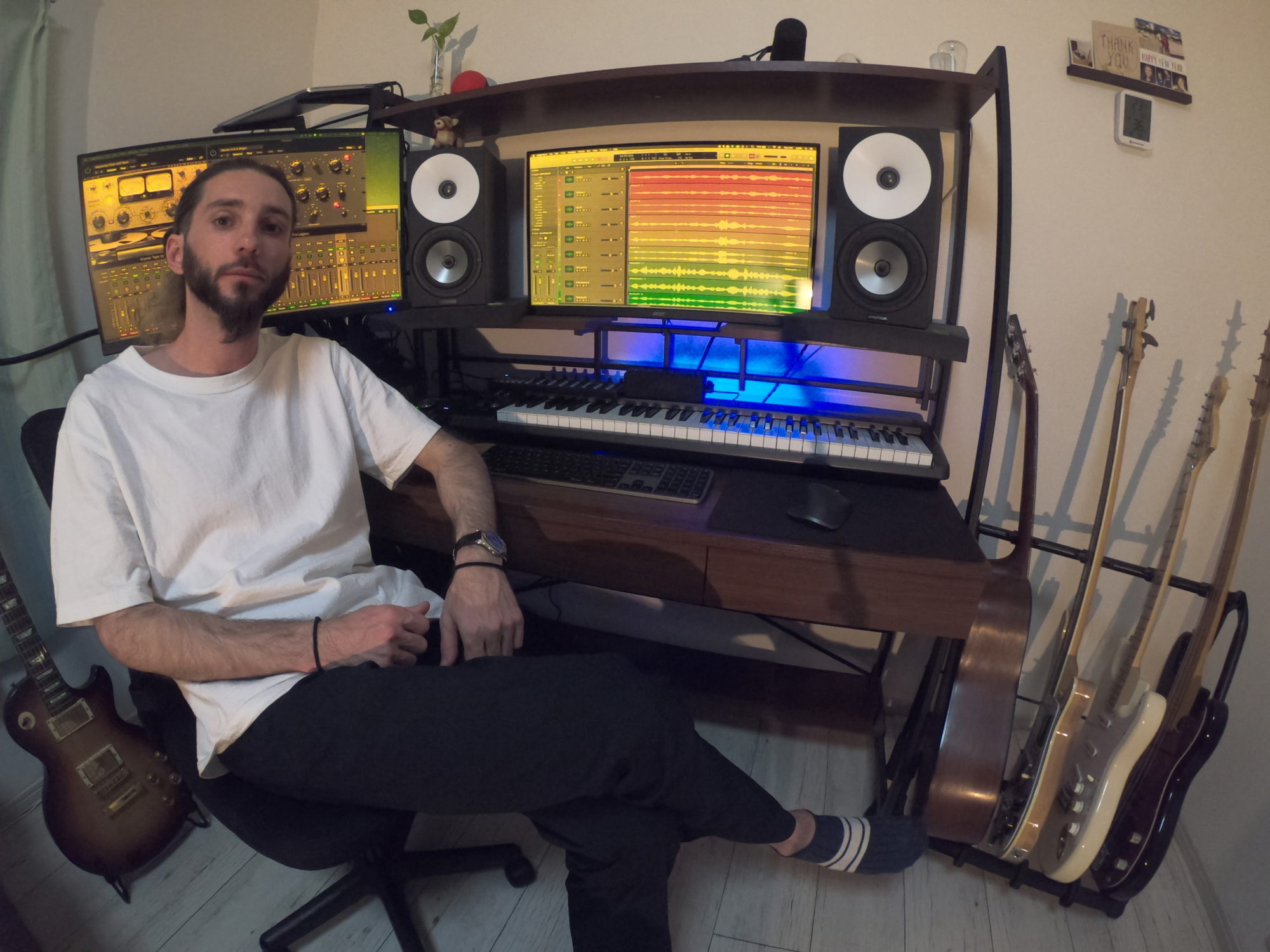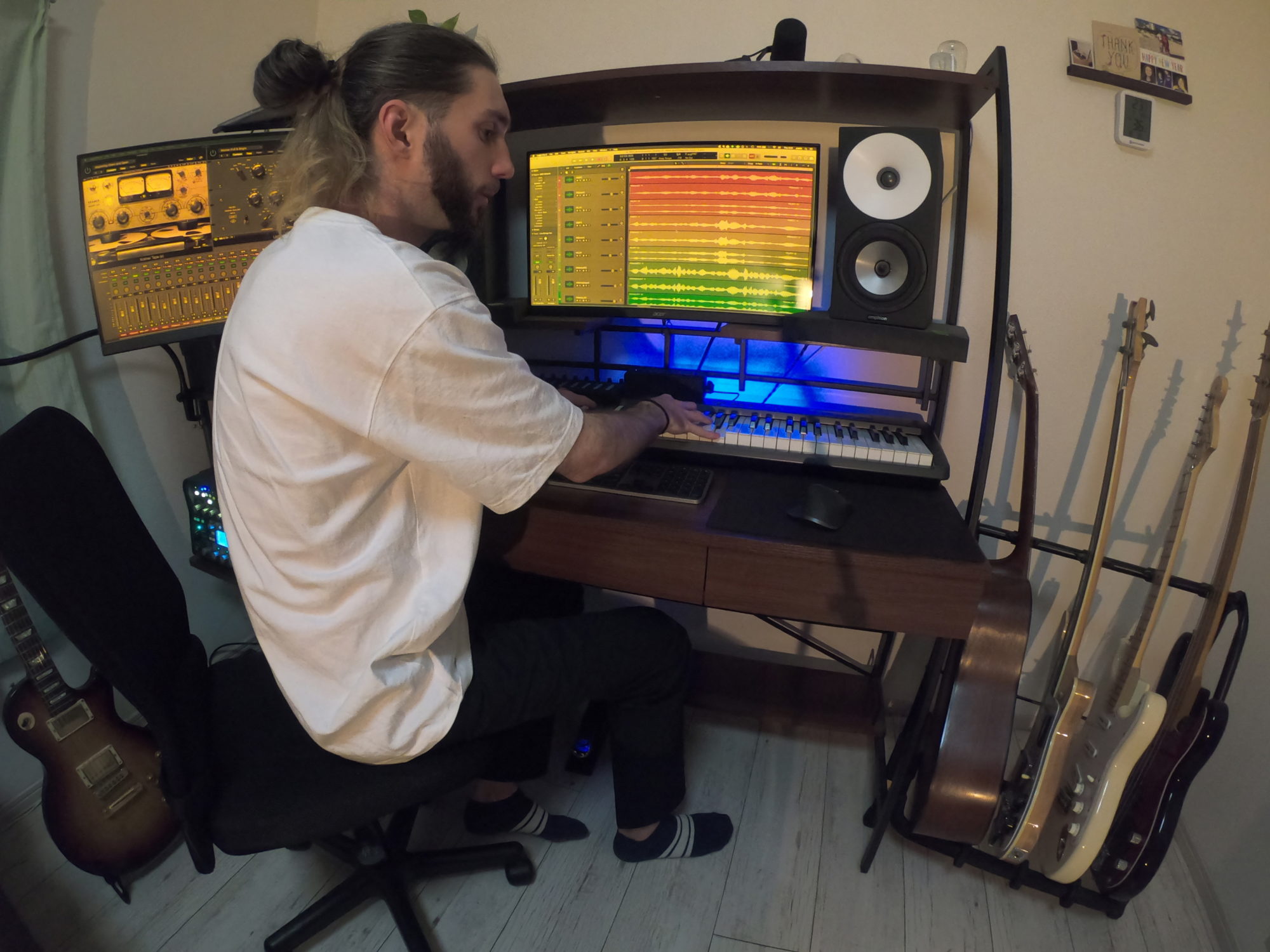Justin Frieden Talks of Sound Design and the Brilliant Clarity of Amphion One15
Songwriter/composer on the transparency and accuracy needed when working with multiple genres in screen music
Tokyo, Japan | Los Angeles, USA – Working between two very cosmopolitan cities, classically trained Justin Frieden is foremost a songwriter, arranger, and composer, as well as a sound-designer/engineer. He relishes the opportunity to assist performers and ensembles bridge the East-West gap. On graduating from University of California Santa Barbara, Justin moved into the Hollywood scene composing for film and television, then relocated to Tokyo to drive the music/sound behind large corporate advert-campaigns and work with numerous high-profile artists and studios including “Final Fantasy” with Ariana Grande; Arranger for Japan’s national broadcaster NHK “Uta-Con”; and TVCMs for Asics, Amazon Business, Mercedes Benz, Microsoft, Renault et al. In the film sector, in the role of sound department manager, he has worked on such films as “Silence”, “Transformers”, “The Last Knight”, “Pacific Rim Uprising”, “Madoff”, and “Mozart in the Jungle”. Our Tokyo office put some questions to Justin, a long-time Amphion user, on both his dual-location work/life experiences, and how integral Amphion is to his workflow:

As a Songwriter/Composer, Sound-Designer/Engineer … who are some of your main mentors or major influencers in both these segments?
I’d have to say Joe Hisaishi (“Spirited Away”), Yoko Kanno (Ghost in a Shell”), and John Williams (“Jaws”, “Star Wars”) are the most influential and inspiring composers for me. And game music, especially the Japanese versions such as the “Final Fantasy” series, old games like “Streetfighter”, “Metroid”, and “Capcom”, and almost all music and sound that comes from Nintendo (especially the “Zelda” series) have also been influential. As for singer-songwriters, Australian Matt Corby (“Miracle Love”) and American Theo Katzman (“Face the Fire” w/Michelle Chamuel) have had a great impact. In addition, I’m a Metal fan, so Dark Tranquillity, Skeleton Witch, and August Burns music really resonate with me too. I really am a classical, metal, and game-music guy through and through.
Tell us about your home-studio set-up … What is your current gear-list ie. racks, outboard gear, audio-interfaces, DAWs, monitors? What’s your creative process? Groove first? Melody first? Where do you source your songwriting/composing ideas from? What is the catalyst? Do you work to a formula?
My setup is really simple these days. I got rid of a lot of my analogue gear, as if I need to tap that tech I will collaborate with a studio which has everything you could dream of gear-wise. Currently, my home studio gear line-up is: UAD MKII Apollo, Kemper profiling amp, Amphion One15, M-Audio Key station, and Korg Nanokontrol. Simple and sweet ! As for DAW and Plugins, Logic Pro X, Protools, Kontakt, Spectrasonics, Fabfilters, Waves, Izotope, Sound Toys, Softtube, and UAD cover all my needs. And instruments I currently carry: Japan Fender Strat, Gibson, Les Paul Studio, Martin Custom D, Fender P Bass, Yamaha Nippon Gakki Nylon string, and Greco Rickenbacker Bass.
As for my process … It generally it starts with an idea/chord/motif … some kind of nice piano chord or voicing, or a guitar chord groove, or sometimes an orchestral theme just pops into my head. On occasion, I might have heard a cool album and some awesome harps and mellotrons triggers me or it could even be something sonically unique I am playing around with. What I find enjoyable is when a client or a musician comes to me with a cool concept like “Hey ! We have this video or this space and need tropical or luxury or upbeat music… and we need 3 hours of it… what should we do?” Then we often pick and build references together and get excited about creating something cool and unique together. Some recent cool references I can remember just off the top of my head are: Pietro Mascagni’s “Cavalleria Rusticana” or Jon Brion’s “Punch-Drunk Love”.
Freelance engineers, young music creators, rising-star producers … What sort of advice can you give them regarding work-ethic and production-standards that will give them an “edge” in a saturated and extremely competitive music market, and in particular, doing “international business”?
Present your niche. Hone-in and focus on your sound or your content and learn to present that. Basically, self-branding is the way forward. Whether you are a singer-songwriter or a composer/producer such as me, you should have a service and a sound that the person listening or purchasing should be able to easily understand. You need to be marketable and translatable. A lot of gigs I get are people wanting to work with an international team or client or want a western sound or touch. Easy to brand myself here in that sense.

You’ve been using Amphion gear for some time now. Which models have you used, and on what sort of projects ? What are some characteristics of Amphions that really contribute to your workflow?
I use the One15s generally, but I have also worked with the One18s and Two18s. I love the clarity they bring in my workflow. The sound is ultra-clear and true to what I am producing and has a sort of sweet clarity to it that I like. Compared to working brands that I had before, I feel like I can work far longer on the Amphions and there is less stress on my ears after a long day – which I attribute to the clear, unchanged presence that the Amphions embody. A typical day in the studio for me could start with some general emailing then switch to working on a demo for a commercial, then maybe a rock track or string arrangement, followed by checking data for a TVCM mix or MA and starting on some sound design and overall balance.
Throughout the various kinds of music and audio work I could possibly do in a day, the One15s are there working effortlessly getting the job done. I never have to worry about something not sounding true to what I produce or having too much or too little bass, like I found have with other speaker brands. The “wow” factor that the Amphions give me is being able to hear everything separately. If I am working on a rock orchestral track with heavy guitars, big strings, and drums on an AAA game, I can hear everything easily and with great clarity. Again, the Amphion speakers are there and present and getting me to the end of my day with ease. And at the end of the day my ears are just not at all tired. The one 15s are also a great size for my home studio where 75% of my workflow takes place.
What’s coming out soon or what have you produced lately? Tell us about your “process” of creating…
Lately I’ve just been working with a full orchestra for an AAA game soundtrack with Square Enix (the “Dragon Quest”, “Final Fantasy”, “Kingdom Hearts” entertainment conglomerate) which is coming out soon. But most recently, I completed the soundtrack for a Renault TV CM – revamping Vivaldi’s “Summer” into a modern arrangement recorded for strings – with both the arrangement and final sound mix completed on the Amphions. Working with one of Tokyo’s most powerful and creative Ad Agencies (TYO・Taiyoukikaku) the creative direction was to try to retain the natural elegance of this French SUV while showing the younger modern power it holds. After narrowing the direction down from 20 Classical masterpieces, it was decided that the best match was Vivaldi’s work, with its aggressive melodies and powerful yet tasteful baroque essence. Electronic string orchestras and powerful dubstep synths & drums were mixed with live recorded strings to produce this impactful yet intellectual music.
Other projects I’ve recently completed fall into the “documentary” category eg. the sound and music for Vice Japan’s “audio documentary” about the Japanese Yakuza – a 4-hour program detailing some of the most gripping accounts of some of the most powerful Yakuza players in Japanese history. There’s a link at the base of this article that sends you to a Japanese-language page with a sample of the work. The other project is a post-3/11 disaster documentary for Patagonia (Japan).It delves into the story of the Tsuboguchi Agricultural Future Research Institute and how they began to question the usage of electricity – in the wake of the Fukushima Nuclear Power Plant accident – and what the local farmers in Toyoka City are doing to work with the environment. Featuring an eclectic score, ranging from cheerful acoustic to mellow ambient, the music sets the scene for the viewer and puts them in the dynamic environment of the farmers. The music, mix, and sound design for all these projects have been completed with my trusty Amphions. Click image below for the video:
More information about Justin Frieden Music
More information Justin Frieden | Vice Japan
More information about One15 – Amphion Loudspeakers